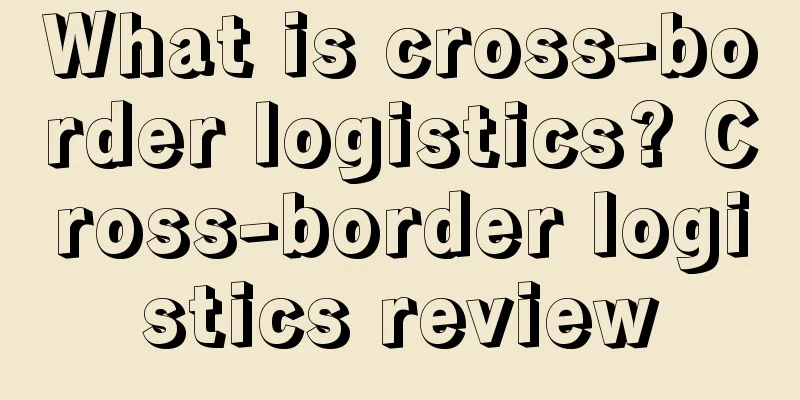What is cross-border logistics? Cross-border logistics review

Cross -border logistics refers to the planning, implementation and control management process of the effective flow and storage of physical objects and information with both sides of the customs border as endpoints.Main modes of cross-border e-commerce logisticsThe first common type is international parcels and international express.According to incomplete statistics, 70% of the parcels of China's cross-border e-commerce export business are delivered through the postal system, of which China Post accounts for about 50%. Although the postal network basically covers the world, the transportation time is long and the package loss rate is high. The second is international express delivery.It is mainly handled by the four giants UPS, Fedex, DHL, and TNT. International express delivery is fast and provides a good customer experience, but it is expensive. For example, if you use UPS to send a package from China to the United States, it can arrive within 48 hours. The third type is overseas warehouse.Sellers first store the goods in overseas warehouses, and then sort, pack and deliver the goods on a large scale according to the order situation. Although this solves the problems of high costs and long delivery cycles in the era of small packages, it also has problems such as easy overstocking and high operation and maintenance costs. The fourth type is cross-border dedicated logistics.Generally, the goods are transported abroad by chartering an air cargo cabin, and then delivered within the destination country by a cooperative company. This method reduces costs through economies of scale, but the scope of collection in China is relatively limited, and the coverage area needs to be expanded. The fifth type is the internationalization service of domestic express delivery.Both STO and SF Express have made early arrangements in cross-border logistics. However, since they are not focused on cross-border business, the overseas markets they cover are relatively limited. FeaturesFirst, competition is concentrated in the southeastern coastal areas, while there is less competition in the central and western regions.Due to the developed economy in the southeastern coastal areas such as the Bohai Sea Rim, the Yangtze River Delta, and the Pearl River Delta, there is a strong demand for cross-border transportation, and the relatively complete infrastructure such as sea and air transportation in the region, so the competition for cargo sources and transportation resources is the most intense. In the central and western regions, due to the relatively inactive economy, there is less demand for cross-border transportation, and the transportation cost is higher, so the region has less investment in international freight forwarding service resources. Second, competition within a region or a single industry is fierce, while cross-regional and cross-industry competition is less.Although there are many market competitors in the cross-border logistics industry, due to the limitations of their own financial strength, management and technical capabilities, as well as the fragmentation of the national logistics market, the competition is manifested in the competition between companies in a certain regional market, such as the competition between cross-border logistics companies in the Yangtze River Delta region; or the competition for customer resources in a certain industry, such as the competition for customer resources in the electronics manufacturing industry, while there is less cross-regional and cross-industry competition. Third, the service functions are single, there are few value-added services, and homogeneous competition is more serious.Most cross-border logistics companies can only provide sea or air logistics services. There are few cross-border logistics companies that can provide multimodal transport (such as sea-air transport) and meet other different needs of customers. When providing cross-border logistics services, they are limited to traditional services such as customs declaration and booking, and provide fewer optimized transportation solution designs and comprehensive logistics services. Therefore, the phenomenon of homogeneous competition is more serious. References
|
<<: What is land transport? Land transport review
>>: What is Two-Step Verification? Two-Step Verification Review
Recommend
Starting from scratch, Shopify's 30-day store opening tutorial - Day 10
After getting the first order from the store, you...
Purchasing power increased by 69%! This group of people in the United States cannot be ignored!
<span data-shimo-docs="[[20,"获悉,根据尼尔森的报告,目...
Amazon's best-selling product with monthly sales of 40,000, domestic sellers have been approved for patents!
Author | Shidu, Nicole Disclaimer | This article i...
Musk sells 4 billion shares to operate Twitter! Tesla stock plummets! Net worth falls below $200 billion
It is learned that in the face of increasing compe...
US FDA urgently authorizes a large number of Chinese KN95 masks to be exported, and 46 factories are authorized!
According to the real-time statistics system of gl...
U.S. Candy Market Survey: Candy Sales Soar to $42 Billion in 2022
It is learned that according to the National Confe...
Domestic e-commerce giants are launching overseas expansion! Temu and TikTok have achieved great success!
Get the "2022 Cross-border E-commerce Annual ...
The principles of direct reviews on Amazon and the advantages and disadvantages of direct reviews
What does Amazon direct review mean? Just like th...
FedEx and UPS raising rates in 2023! Ground package delivery costs hit record high!
Ground package delivery costs hit a record high in...
Big news of the week! Amazon's French warehouse closure will be extended to at least April 22
1. Amazon deploys infrared thermal imaging camera...
Sharing experience on how to avoid fake orders on Amazon
1. Assessment Requirements Buyer quality The order...
Free service? Plus a tax ID! It’s finally Amazon’s turn to make the most of it!
Sellers all joke that they are the leeks raised by...
What is Amazon Storefronts? Amazon Storefronts Review
Amazon Storefronts is an exclusive landing page fo...
What is Marks & Spencer? Marks & Spencer Review
Marks & Spencer was founded in the UK in 1884....
Critical hit! Small and light commodity plan cancelled, Amazon adjusts FBA delivery fees again
Half a year later , Amazon has once again extended...









